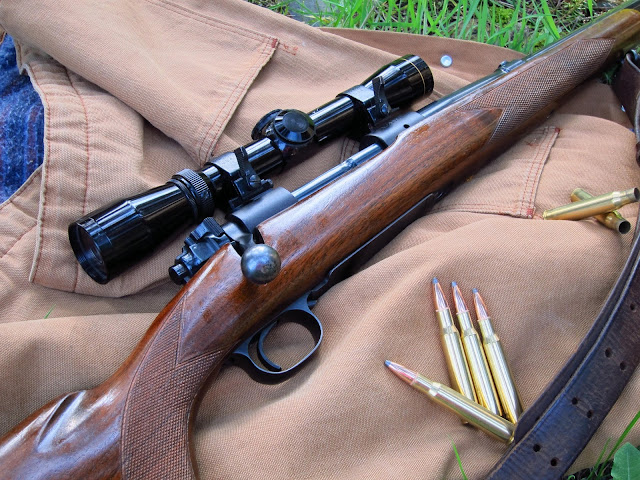S&W 686-4 Round Butt Stainless Steel.
I picked up this beauty of a revolver a few days ago, I've been wanting a 4" S&W to match my 4" Colt Python (currently at Colt for servicing, I'll post a full write up and pictures when it returns.) This can be had for about half the price of a Python, and in stainless steel it makes an excellent all weather outdoors gun.

This is my first S&W newer production revolver, built between 1993-1997, now its almost 20 years old. These guns have recently come more into the spotlight because they are considered by some to be S&W's answer to the Colt Python, and many people (myself included) don't see the current production models as matching the higher quality of the older models. Indeed the 686 and Python fit the same holsters, have the same dimensions and even look slightly similar. The looks can be deceiving, because this is not a Colt Python, and should not be compared to one. Although I will admit that I purchased this one because I already have the holster and ammo to go with it for my Python.

Firing the .357 Magnum and the .38 Special cartridge, this revolver delivers the power necessary to take most critters, both four legged and two legged in the lower 48, and offers a recoil that is not overly harsh to the user under full power loadings. I am perfectly at home shooting full power .44 Mag if the need arises, but I like to operate by two is one and one is none, meaning that if I can only reliably pull off one fast shot of .44 Mag, I'd rather have two reliable and fast shots of .357 Mag instead.
Note that the front sight has the high-vis orange insert and is one solid piece with the barrel and under lug. This revolver is by no means a lightweight, and you will feel the pull on your hip. I like the extra heft and prefer how the gun draws and points compared to the air weight revolvers that are offered these days. This gun is built to take heavy usage at the range and in the field and will outlast me and likely my children's children.
The extractor reaches far enough that I can eject my spent casings quickly to facilitate a speed loader reload. The rear sight is adjustable with a nice white outline notch that in practice, aids aiming for quick shots. This 686 has the classic standard S&W hammer and pinned firing pin that was dropped from later models. I don't have any tests to confirm if the later used MIM trigger and hammer parts are inferior, but I like knowing that my hammer and trigger group parts were forged and case hardened rather than made from pressed metal sawdust.

This model sports a big gnarly Hogue wood mono-grip, and for someone with small hands, it's like grasping a loaf of wheat bread stuck to your revolver. The frame on this particular 686 is the round butt variant vice the more common square butt, and these grips are a set of conversion grips that just don't help me a whole lot. I've ordered some more acceptable and less chunky grips that should solve the problem and I'll post some updated pictures when they arrive.

Pre-lock S&W revolvers are bringing a premium over the newer revolvers that have the lock above the cylinder catch. I won't go into detail about some of the dirty nicknames that the lock hole has garnered, but suffice to say that most people don't prefer the lock. I rationalize it like so; why add extra parts to the internals of a simple and reliable machine. I don't leave my firearms un-attended and I just don't know when I would use the lock. If you routinely need a lock and key combination for the internal action of your firearm you should review your storage and handling practices.
I'd imagine the introduction of the lock went something like this...
Smith and Wesson design team vs S&W lawyers in a boardroom meeting...
Lawyers: Enthusiastically "Yea, and we should put a tiny lock on its internals"
Design: Sarcastically "Uh, to make it safer, right?"
Lawyers: Enthusiastically "Yup, and you should make the hole real tiny so that it will get clogged with belly button lint, dirt, and debris. Put the hole near where people's grubby fingers will go!"
Design: Sarcastically "Do you want us to make a really small, easily misplace-able key to go in the lock?"
Lawyers: Enthusiastically "Oh yes, that would be the best"
Design: Angrily "And I suppose next week you'll be asking us to use metal sawdust to make our parts cheaper"
Accountants (also in the meeting): Excitedly "Wait, we can do that?"
Design: Throws up hands and storms out of the room....
The 686 is a really robust and practical gun for the money. It's not a Colt Python, but as I stated before this one cost me about $800 less, and for that kind of money it's like comparing a Seiko to a Rolex, nothing wrong with either choice, but not in the same production bracket. I'll most likely lug my 686 around this summer in the Cascades and Olympics, while my Python is reserved for my "BBQ Gun" (Look up the term if you are unfamiliar) The stainless steel of the 686 will care less if I trip and fall into a swamp or get caught in one of the ever present rain storms here in the Northwest. If you have a chance to acquire one of the older model 686s at a reasonable price, don't hesitate. These revolvers will only appreciate in value and collect-ability, and much like their cousins, the Colt Python, they will become more endangered as classic American revolvers cease production.









































